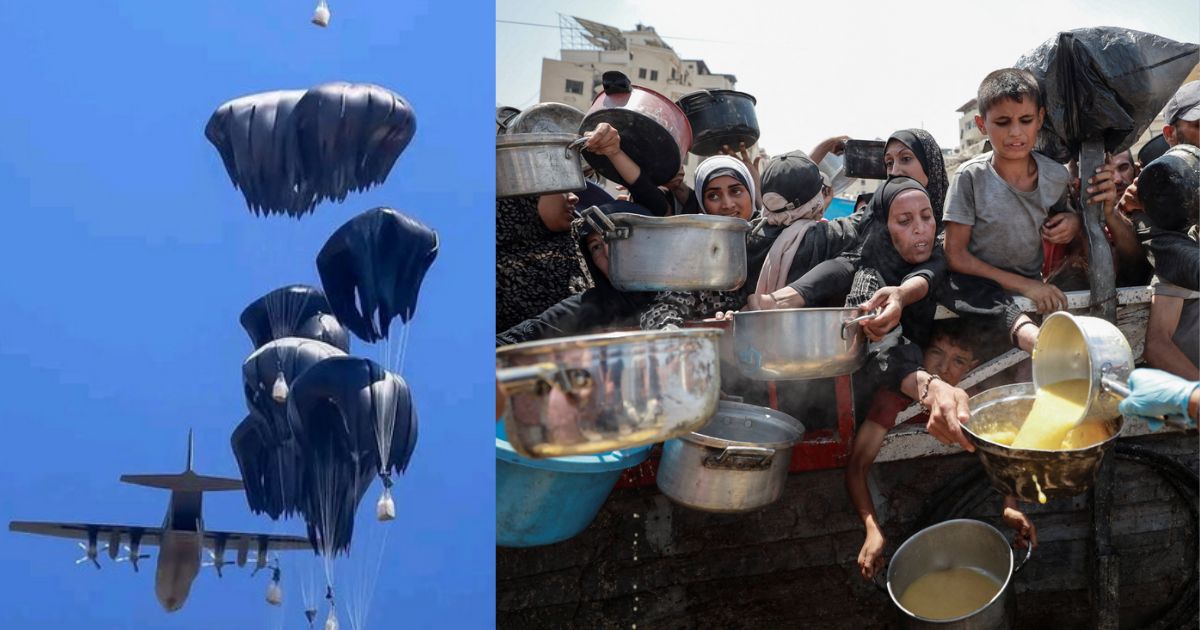The United Nations has sharply condemned recent airdrops of humanitarian aid into Gaza, criticizing them as an inadequate response to a deepening starvation crisis worsened by Israel’s ongoing blockade.
With hunger reaching catastrophic proportions, almost half a million people in Gaza now face famine-like conditions, and a third of the population struggles daily without food. The World Health Organization recently highlighted that, of 74 malnutrition-related deaths in 2025, 63 occurred in July alone, tragically including 24 children under five.
The agency stressed, “the crisis remains entirely preventable” and that “deliberate blocking and delay of large-scale food, health, and humanitarian aid has cost many lives.”
Despite these warnings, several countries, including Jordan, the United Arab Emirates, and Israel, have begun parachuting aid packages into Gaza, marking the first airdrops in months. However, aid organizations have condemned this practice, calling it a “grotesque distraction” that does nothing to address the real roots of starvation.
The airdrop of aid into the #Gaza Strip is yet another act of humiliation and degradation against Palestinians. It endangers civilians crowded into less than 15 per cent of the enclave and serves a graver purpose: enabling Israel’s policy of mass starvation, deliberately used as… pic.twitter.com/xcq1c6zQRO
— Euro-Med Monitor (@EuroMedHR) July 28, 2025
Philippe Lazzarini, commissioner-general of UNRWA, denounced the airdrops as “expensive, inefficient & can even kill starving civilians. It is a distraction & screensmoke. Man-made hunger can only be addressed by political will. Lift the siege, open the gates & guarantee safe movements and dignified access to people in need.”
View this post on Instagram
Airdrops, typically reserved as a last resort when aid cannot reach its destination by road, involve parachuting packages of food and essentials from planes. Ideally, staff on the ground are ready to collect them at predetermined locations.
However, the immense dangers of this method in Gaza’s densely populated environment are drawing grave concern. Humanitarian organizations warn that “you cannot safely aim a pallet of aid,” as Médecins Sans Frontières operations manager Jacob Burns put it.
He added, “People have already been killed by aid drops in Gaza.” These risks became tragically clear when a parachute reportedly failed last year, resulting in five deaths as an aid package crashed directly onto people below.
View this post on Instagram
Beyond the risk of physical harm, the desperation among starving residents leads to dangerous crowds rushing toward dropped food. “If you’re starving and suddenly you see food drop out of the sky, obviously you’re going to run towards that aid and it’s a situation where the strongest will win,” Burns explained.
The chaos raises additional problems as Burns added, “If you’re just throwing aid randomly into the Gaza Strip, then you have no idea who can control that.” Military analyst Sean Bell further noted that some airdropped aid has already been “looted by gangs and is on the black market.”
New steps to improve the humanitarian response in Gaza:
✈️Aerial airdrops of aid will resume. The airdrop includes 7 pallets of aid containing flour, sugar, and canned food.
🚚Designated humanitarian to enable safe movement of UN convoys delivering food and medicine.… pic.twitter.com/bCqCnI1HGL— Israel Defense Forces (@IDF) July 26, 2025
He also observed the inherent dangers for aircraft over warzones, “When these parcels hit the ground, there’s a significant danger of them hitting people, and the volume of aid dropped is pitifully insufficient, as “aircraft can only deliver one truckload of aid. Gaza needs 500 truckloads a day, so it’s 0.2% of the daily need.”













